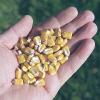(Beyond Pesticides, October 14, 2010) Over 13,000 organizations and individuals -consumers, parents, health advocates, farmworkers and others- from across the U.S. sent a letter to the Environmental Protection Agency (EPA) yesterday calling for a ban on the insecticide chlorpyrifos and a phase out of other organophosphate (OP) pesticides. Chlorpyrifos was phased out for residential use under a 2000 agreement between EPA and Dow Agrosciences, but continues to expose farmworkers and consumers through its use in agriculture.
Also on October 13, the Endocrine Disruption Exchange (TEDX), led by renowned scientist Theo Colborn, PhD, announced the addition of chlorpyrifos to its online database, Critical Windows of Development, spotlighting research that links prenatal, low dose chlorpyrifos exposure to altered health outcomes in the brain and other organs.
“Human studies have now linked prenatal exposure to chlorpyrifos with mental and developmental delays emphasizing even more the urgency to remove the product from the market,” said Dr. Colborn, President of TEDX and a signatory on the letter. “Chlorpyrifos illustrates the urgent need to be cautious, prevent further exposure and protect our children from the time they are conceived onward.”
Beyond Pesticides calls EPA’s 2000 chlorpyrifos settlement with Dow a classic failure of the risk assessment process under the Food Quality Protection Act (FQPA) —a failure that is repeated over and over again in agency chemical regulation decisions. Advocates have pointed to chlorpyrifos as the poster child for why risk assessment does not work to protect the public, workers and the environment, even with safer practices and products available in the marketplace. EPA’s decision in 2000 and subsequent action removed chlorpyrifos’ residential uses and retains all agricultural uses except tomatoes (allowable residues on apples and grapes were adjusted), golf course and public health mosquito spraying. The agency argued at the time of its decision that it had adequately mitigated risks through the removal of high exposure uses to children in the residential setting, but ignored the special risks to farmworker children’s exposure as well as the availability of alternative agricultural practices and products that made chlorpyrifos unnecessary and therefore its risks unreasonable. The decision at the time was hailed as a victory for the public because it eliminated high hazard exposures and showed that EPA could remove uses of a widely used chemical. Except, it did not do the job. The risk assessment process does not force a consideration of those who suffer disproportionate risk or groups of people (such as those with neurological diseases in this case who are disproportionately affected).
Chlorpyrifos is a neurotoxic insecticide whose use was found to exceed acceptable rates of illness, especially to children. By focusing on risk reduction strategies to come up with “acceptable,” but unnecessary, rates of illness across the population, EPA virtually ignored the chemical’s widespread use in agriculture, resulting in exposure to farmworkers, farm families and others living near agricultural areas. It is also a frequent water contaminant and a long range contaminant, exposing communities and contaminating pristine areas far from where it was applied. Short term effects of exposure to chlorpyrifos include chest tightness, blurred vision, headaches, coughing and wheezing, weakness, nausea and vomiting, coma, seizures, and even death. Prenatal and early childhood exposure has been linked to low birth weights, developmental delays, ADHD and other health effects.
David Carpenter, M.D., Director of the Institute for Health and the Environment at the University at Albany (State University of New York) said, “It is unacceptable that farmworker children, and children in the general population continue to be exposed to these neurotoxins.”
“As more families cope with the suffering and costs of learning and developmental disabilities and attention problems, EPA must prevent further exposures to neurotoxic pesticides,” said Maureen Swanson of the Learning Disabilities Association of America. “EPA needs to protect people, especially children and pregnant women, from any chemical that threatens brain development. In addition to banning neurotoxic pesticides, we must reform the Toxic Substance Control Act to require EPA to address the many neurotoxic chemicals in our everyday products.”
“The last time EPA reviewed these pesticides, its own scientists complained that the Agency was not assuring adequate protection of the nation’s children, and that it was unduly influenced by those it regulates,” said William Hirzy, Ph.D., a professor at American University in Washington D.C. and a former EPA chemist. While at EPA, Dr. Hirzy was involved in a letter raising these concerns sent to management by six unions representing 9000 EPA scientists and other staff, as the Agency was finalizing its Cumulative Risk Assessment for organophosphates in 2006. “Five years later, with even more sobering studies in hand, will EPA finally act to protect children?,” Dr. Hirzy asked.
Chlorpyrifos is used widely on corn, orchard, and vegetable row crops all over the country. While it is known to contaminate dozens of fruits and vegetables with detectable residues, Beyond Pesticides’ Eating with a Conscience database reveals that chlorpyrifos is also registered for use on more than half of the 15 “cleanest” fruits and vegetables, or those with the lowest pesticide residues (asparagus, cabbage, corn, grapefruit, kiwi fruit, onion, peas and sweet potatoes). So while there may be little residue remaining by the time it reaches your store shelf, these crops may be grown with hazardous pesticides that get into waterways and groundwater, contaminate nearby communities, poison farmworkers, and kill wildlife, while not all showing up at detectable levels on our food. An estimated 8 to 10 million pounds of chlorpyrifos are applied to U.S. crops each year (see a U.S. Geological Survey map showing where chlorpyrifos is used.)
“The warning signs have been obvious for decades, yet EPA has allowed generation after generation to suffer exposures and consequences,” said Carol Dansereau, Executive Director of the Farm Worker Pesticide Project, a Washington State farmworker organization that initiated the letter to EPA. “EPA is promising to better protect children and other vulnerable people, but that promise is meaningless as long as it keeps reregistering chlorpyrifos and other organophosphates, ” she said. FWPP and others are asking the public to contact EPA and join in demanding a ban, and precaution-based policies.
“Unfortunately chlorpyrifos and other organophosphates do not stay where sprayed. They evaporate and move with wind and fog. That’s how they contaminated our fields,” said Larry Jacobs of Jacobs Farm/Del Cabo, an organic grower in California. “There are better ways to manage insect pests than depending on organophosphates like chlorpyrifos. We signed onto the letter to EPA to protect our health and to protect our farm.”
EPA is in the process of considering re-registration for chlorpyrifos, one of the most widely used pesticides in agriculture in the US and worldwide.
Beyond Pesticides advocates for the national conversion to organic systems planning, which moves chemicals off the market quickly and replaces them with green management practices. The chlorpyrifos story, in addition to untold damage it has caused families across the U.S., is testimony to the need to adopt alternatives assessments that force chemicals off the market that can be replaced by safer or green practices. Despite agency efforts to use failed risk assessment decision making to claim that the food supply is safe and the environment protected, an informed public is driving the growth of organic production in the marketplace, choosing health and environmental protection over risk assessment. It is a process that can be supported through purchasing decisions everyday in the grocery store and advocacy that effects a conversion of land and building management in parks, schools, lawns and gardens, health care facilities, indoor and outdoor spaces to nontoxic and least-toxic methods. Whether it is agriculture, schools, lawns and gardens, health care facilities, or community insect management, turn to Beyond Pesticides for the latest on science, policy, safe management practices, and activism.
For more information, contact:
* Carol Dansereau, Farm Worker Pesticide Project, 206-729-0498; [email protected]
* Stephenie Hendricks, 415-258-9151, [email protected]
* Ana Duncan Pardo, Toxic-Free North Carolina, 919-818-5933, [email protected]
* John Kepner, Beyond Pesticides, 202-543-5450, [email protected]














